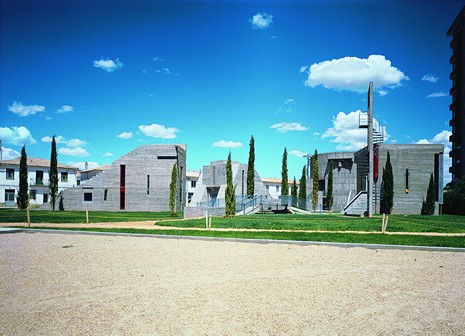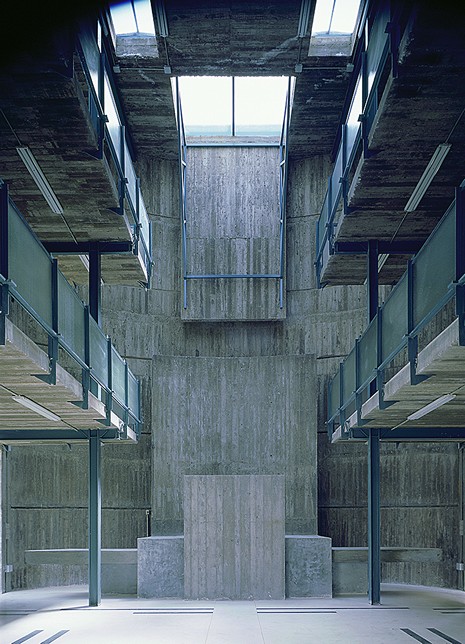Description
Almazán is a small community of only 5800 inhabitants located in the Castilian highlands some 30 kilometres south of Soria. The Parque de San Francisco lies to the east of the centre of Almazán, next to a north-south road that separates the periphery from the centre. The level site has an elongated pentagonal form that grows progressively narrower towards the rear. Covered largely with lawn and a few spindly conifers, the Parque is bounded on the north by a row of newly-built white houses, to the south by a similar row of brown houses. In the midst of its urban surroundings, the Parque is so large that it appears like a desolate area. The bullring built nearby only strengthens the impression of a “barren” area left to progress at its own pace.
Four buildings made of rough in-situ concrete stand loosely arranged at the rear of the pentagon. The first of these has a wedge-shaped form and functions as a dwelling and office. The second has the form of a cube and is a house for children. The third is a pyramid and serves as a chapel. The fourth is cylindrical and is a church. Originally, the buildings were to be connected by two footpaths that were to cross precisely in the centre of the site. The wedge and cube housing the profane functions were to form the ends of one axis, the pyramid and cylinder housing the sacred functions the ends of the other axis. In this arrangement, the ensemble would have had an inward focus, turning its back on its surroundings.
It seems that, for a while, the architect saw only the “vulgarity of the periphery” in the surrounding context of the park. That he eventually overturned his earlier inward arrangement is evident in the arrangement of the buildings. The constellation now establishes a connection, if somewhat distant, to the centre of Almazán. The intersecting axes have now been shifted from the centre to the western edge of the 1500 square metres large plot. Here, at the point where the Parque de San Francisco tapers markedly in an easterly direction, a stair and a bridge crossing as well as a “campanile” – without bells, but with elevated crow’s nest at the top of a spiral stair – mark the entrance to the “sacred space”. The wedge and cube stand at each end of the transverse axis, on the left and the right. The pyramid stands to one side of the longitudinal axis with the cylinder at the rear. The hierarchy of the architecture is immediately apparent: the profane in the foreground, the sacred in the background. The church forms the focal point of the entire ensemble. It is the largest and tallest building and, as if to emphasise its stature still further, the shuttering marks on its concrete walls are entirely vertical.
Arriving from the west edge of the Parque, one passes the wedge with the dwelling and offices on the left and advances towards the pyramid of the chapel. Its upright long sides and inclined short sides are almost entirely plain surfaces, forming a square of 10 by 7 metres. On the shallower of the two inclines, two flights of steps lead onto the roof. The entrance is in the more steeply inclined façade. Immediately behind the quadratic indentation which frames the double-doors, themselves flanked on either side by half-rounded pilasters, one emerges onto a gallery with a steel-and-glass balustrade. One’s view continues forwards and downwards. Stairs on the left and the right descend a whole storey. At the bottom one stands immediately in front of the altar – a simple, broad-folded leaf of rough concrete – with the sloping wall of the wedge, a single strip of light running along its centre, leaning over it like a protective hand. A small crypt lies well hidden behind the last row of chairs directly beneath the entrance portal.
In paintings of urban scenes from the Quattrocento, the most important building is typically in the centre at the end of a vista. In the Parque de San Francisco, the church fulfils this role at the end of the axis that leads down a gentle descent across the lawn from the bridge crossing. The building has four entrances, none of them in the centre. Two are on the left and right at the end of the ramp, two at the end of two stairs that lead upwards either side of the ramp. The building has a diameter of 12 metres. Although its external appearance is cylindrical, it nevertheless attempts to mediate between the radial and the axial: the interior is a pure cube of 9 by 9 by 9 metres. All indications of the outer cylindrical form are concealed inside by four galleries, again with steel-and-glass balustrades, and their access stairs. The galleries divide the space into three storeys on the one hand, on the other into a central nave and two side aisles to the left and right. This arrangement is reminiscent of a Protestant church; all it is lacking is a pulpit in the “apse” behind and above the altar.
Each of the buildings – wedge, cube, pyramid and cylinder – has been designed as a solitary object. Nevertheless, together they form an ensemble: firstly, through their individual symmetries, evident inside as well as outside in the church and chapel; secondly, through the rough grey materiality of the concrete; thirdly, through the slots and strips of light in each building; fourthly, through the red, green and blue colours used for the steel doors and windows; and lastly, through the numerous stairs that make ascending and descending a characteristic part of each of the four buildings.
The church and chapel in Parque de San Francisco have a specific affinity with Italian architecture. The “solitary pride” of the individual volumes on the lawn is reminiscent of the solitary character of the buildings around Pisa Cathedral. The ample use of profiles and pilasters that frame, step and shuffle the volumes and give special character to the details are clearly influenced by the work of Carlo Scarpa. A renewed emphasis on the value of history as an origin for design and the abandonment of the dogma of modernism derives from the ideas and concepts of the Gruppo Romano Architetti Urbanisti (GRAU), founded in the mid-sixties. In this respect, the church and the chapel refer to Castilian’s heritage as the land of a thousand castles. In this respect, too, their materiality – the concrete, steel tubing, wired glass as well as the cabling and electrical fittings – refers to the architecture of workshops and factory buildings. The form of the chapel goes even further, making almost demonstrative reference to the culture of the Maya civilisation.
Indeed, the church and chapel adopt a precarious position which Spanish architectural critics soon coined as “eclectic rationalism”. The various references from near and far that inform the complex at Almazán are transformed through the design into an idealised constellation in which the divergent, even paradoxical elements are synthesised into an archaic, narrative and highly dramatised aesthetic. Even when the ensemble communicates little of the joy of “glad tidings”, its architecture nevertheless gives us a sense of what Christian believers call the “mystery of faith.”
Arquitectura Viva, no. 94/95/2004, p. 31 | Baldellou, Miguel Angel, Capitel, Antón: Summa artis. Historia general del arte. Vol. XL Arquitectura española del siglo XX, Madrid 1996, pp. 575- | Capitel, Antón, Wang, Wilfried (Ed.): Architektur im 20. Jahrhundert. Spanien, exhibition catalogue, Munich 2000, p. 249 | El Croquis, no. 37/1989, pp. 54- | Das Münster, no. 2/1989, pp. 119- | On Diseño, no. 87/1987, pp. 18- | Rispa, Raúl (Ed.): Birkhäuser Architekturführer. Spanien. 1920-1999, Basel 1998, p. 128 | Techniques et Architecture, no. 371/1987, pp. 116-, p. 140
Drawings
Site plan
Ground floor, church
Second floor, church
Sectional axonometric view of the church
Lower floor, chapel
Ground floor, chapel
Longitudinal section, chapel
Front elevation of the chapel
Rear elevation of the chapel
Photos

View of the four buildings from the west, in the background left the pyramid of the chapel

Interior view toward the altar zone of the church, to the left and right the four galleries
Originally published in: Rudolf Stegers, Sacred Buildings: A Design Manual, Birkhäuser, 2008.